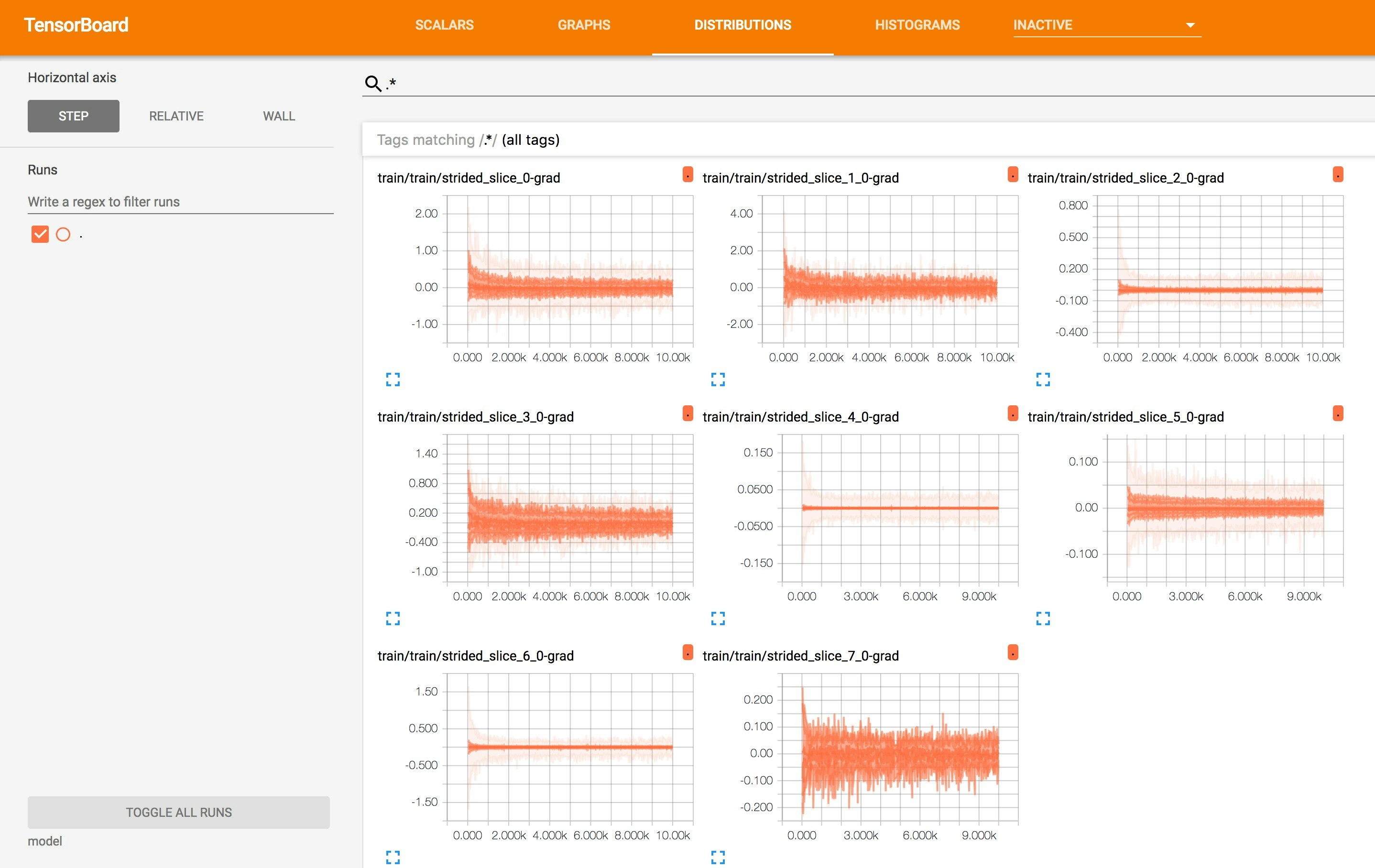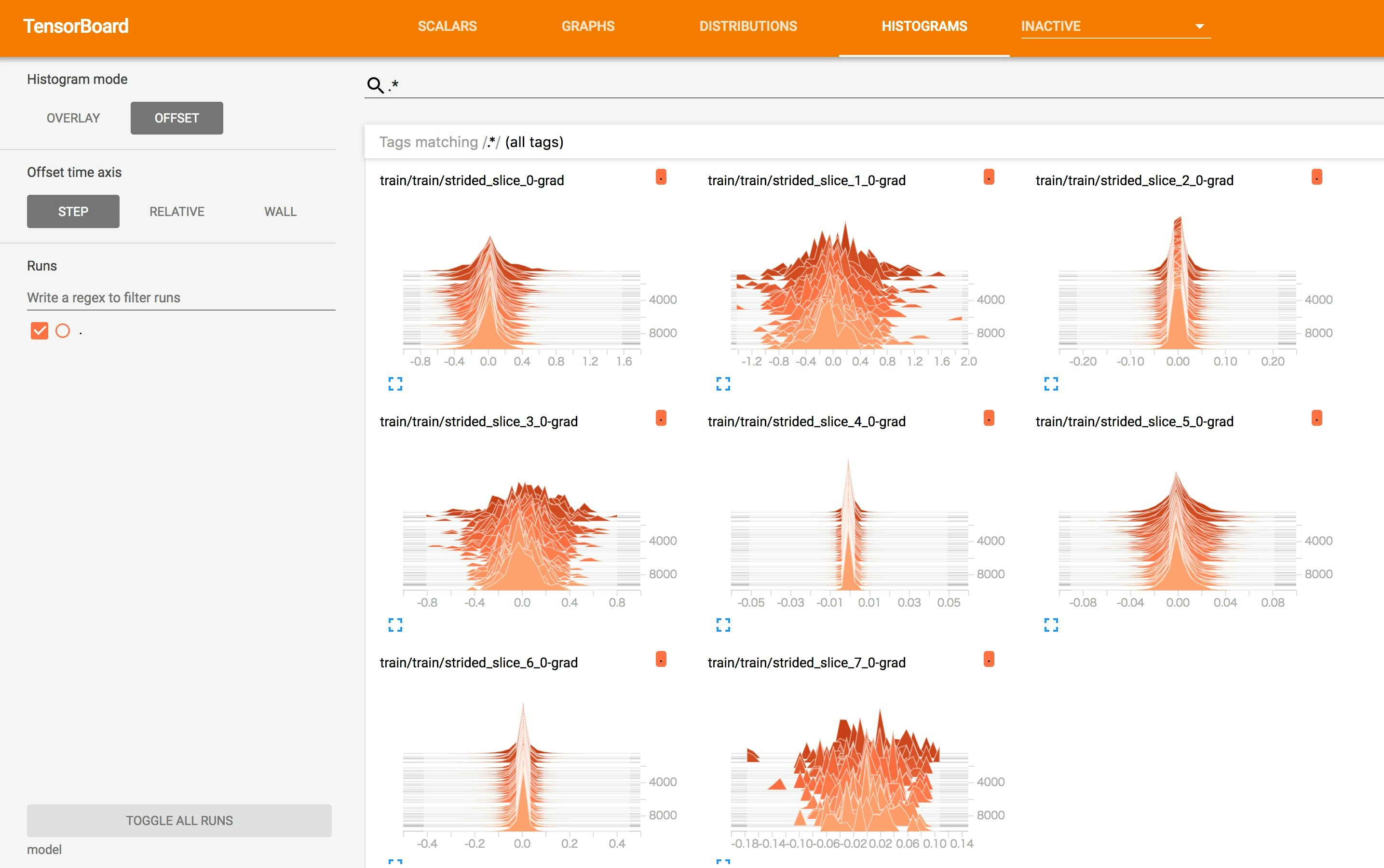tensorflowでのGradients
Reinforcement Learningの主力モデルの一つであるA3Cのモデルを現在勉強中。
その際、数式の中でGradientsの表示が出てきたので、tensorflowでどのように表現することが出来るか探ってみました。
Gradients
今回はGradientsのhistgramを表示することにフォーカスしたいので、MNISTのプログラムからGradientsをどのように取得すべきかを検討してみました。
参考リンク
TensorBoard: Visualizing Learning
TensorBoard: How to plot histogram for gradients?
上記リンクを参考にして記事を書いています。
MNIST単純モデル
まずは、単純なtensorflowのconvolution modelを構築。
2層のconvolution layerからfully_connected層を経て10digitsのOutputsを作成します。
def weight_variable(shape):
initial_value = tf.truncated_normal(shape, stddev=0.1)
W = tf.get_variable("W",initializer=initial_value)
return W
def bias_variable(shape):
initial_value = tf.truncated_normal(shape, 0.0, 0.001)
b = tf.get_variable("b",initializer=initial_value)
return b
def conv2d(x, W, name="conv"):
with tf.variable_scope(name):
return tf.nn.conv2d(x, W, strides=[1, 1, 1, 1], padding='SAME')
def max_pool_2x2(x):
return tf.nn.max_pool(x, ksize=[1, 2, 2, 1],
strides=[1, 2, 2, 1], padding='SAME')
def proc1():
mnist = input_data.read_data_sets("MNIST_data/", one_hot=True)
x = tf.placeholder(tf.float32, [None, 784])
y_ = tf.placeholder(tf.float32, [None, 10])
with tf.variable_scope("mnist") as scope:
name = "conv1"
with tf.variable_scope(name) as scope:
W_conv1 = weight_variable([5, 5, 1, 32])
b_conv1 = bias_variable([32])
x_image = tf.reshape(x, [-1,28,28,1])
h_conv1 = tf.nn.relu(conv2d(x_image, W_conv1, name) + b_conv1)
h_pool1 = max_pool_2x2(h_conv1)
name = "conv2"
with tf.variable_scope(name) as scope:
W_conv2 = weight_variable([5, 5, 32, 64])
b_conv2 = bias_variable([64])
h_conv2 = tf.nn.relu(conv2d(h_pool1, W_conv2, name) + b_conv2)
h_pool2 = max_pool_2x2(h_conv2)
name = "fc1"
with tf.variable_scope(name) as scope:
W_fc1 = weight_variable([7 * 7 * 64, 1024])
b_fc1 = bias_variable([1024])
h_pool2_flat = tf.reshape(h_pool2, [-1, 7*7*64])
h_fc1 = tf.nn.relu(tf.matmul(h_pool2_flat, W_fc1) + b_fc1)
keep_prob = tf.placeholder(tf.float32)
h_fc1_drop = tf.nn.dropout(h_fc1, keep_prob)
name = "fc2"
with tf.variable_scope(name) as scope:
W_fc2 = weight_variable([1024, 10])
b_fc2 = bias_variable([10])
with tf.variable_scope("logits_pred") as scope:
#logits = tf.matmul(x, W) + b
#logits = tf.nn.relu(logits)
logits = tf.matmul(h_fc1_drop, W_fc2) + b_fc2
Trainable_Variables
各層でのそれぞれのweightsを取得したいので、
var = tf.get_collection(tf.GraphKeys.TRAINABLE_VARIABLES,"mnist")
取得したweightsが現状どのようになっているの確認したければ、
for v in var:
if "W" in v.name:
print(v)
とすることで簡易的に確認することができます。あくまでも簡易的です。
Training
train scopeを作成してその中でtensorflowのhistgramを使用してgradientsを出力するようにしています。
with tf.variable_scope("train") as scope:
grads = tf.gradients(cost, var)
gradients = list(zip(grads, var))
regularizer = 0.0
for w in Ws:
regularizer += tf.nn.l2_loss(w)
#
#print(gradients)
beta = 0.01
loss = tf.reduce_mean(cost + beta * regularizer)
opt = tf.train.GradientDescentOptimizer(1e-4)
#train_op = tf.train.AdamOptimizer(1e-4).minimize(loss)
g_and_v = opt.compute_gradients(cost, var)
#p = 1.
#eta = opt._learning_rate
#my_grads_and_vars = [(g-(1/eta)*p, v) for g, v in grads_and_vars]
train_op = opt.apply_gradients(grads_and_vars=g_and_v)
for index, grad in enumerate(g_and_v):
tf.summary.histogram("{}-grad".format(grads[index][1].name), grads[index])
tf.Session()
最後はtf.SessionでmergeされたOperatorをsummary_writerで書き出すことをしています。
merged_summary_op = tf.summary.merge_all()
save_path = None
with tf.Session() as sess:
if save_path is None:
save_path = 'experiments/' + \
strftime("%d-%m-%Y-%H:%M:%S/model", gmtime())
print("No save path specified, so saving to", save_path)
if not os.path.exists(save_path):
logging.debug("%s doesn't exist, so creating" , save_path)
os.makedirs(save_path)
init_op = tf.group(tf.global_variables_initializer(),
tf.local_variables_initializer())
sess.run(init_op)
saver = tf.train.Saver()
summary_writer = tf.summary.FileWriter(save_path, sess.graph)
for it in range(10000):
data,labels = mnist.train.next_batch(32)
#print(data.shape, labels.shape)
feeds = {x:data, y_:labels, keep_prob: 0.5}
train_op.run(feed_dict=feeds)
summary_str = sess.run(merged_summary_op, feed_dict=feeds)
summary_writer.add_summary(summary_str, it)
tensorboardでの結果表示
tensorboardでの結果表示imageを載せておきます。


実行環境:
- ubuntu 16TLS
- tensorflow 1.4
- GTX1080Ti x 1
なお、10000回のiterationにかかる時間は30分以上でした。